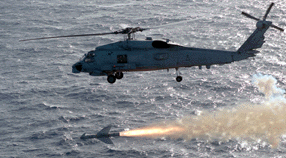Michael Fumento
Factual · Powerful · Original · Iconoclastic
Helicopter Safety Blind Side
January 01, 1999 · Michael Fumento · News World Communications, Inc. · MilitaryA UH-60 Blackhawk helicopter carrying 14 exhausted soldiers is heading back to its desert base camp after a long training exercise. Just as the pilot nods off, a sand dune suddenly appears ahead. The pilot’s earphones scream: "Whoop. Whoop. Pull up. Pull up." In half a second, he’s seized control. By a matter of feet, 14 men avoided returning home in zippered plastic bags.

AH-64A Apache
This last-second rescue never happened, but it could have for the Marines or Navy. Both have mandated such a system for all their helicopters. Yet the Army, with far more helicopters than all the other services combined, refuses to employ these "ground collision avoidance systems" (GCAS).
This is all the more amazing considering that Army helicopter pilot flying hours are far less than they were just a few years ago, human performance is responsible for about 80 percent of all Army aircraft accidents, and more than half of those are what is called "controlled flight into terrain" or CFIT.
CFIT is rarely a combat problem, since pilot’s are most alert then. Usually it’s from fatigue, confusion, distraction, inattention, complacency or the like.
An Army study completed last summer showed that from fiscal 1988 through fiscal 1997, it had 137 serious helicopter accidents. Of these, anti-collision warning systems might have prevented 57 accidents, more than $200 million in equipment damaged and injury costs, and most importantly, 51 deaths.
"It’s pretty surprising that they’re leaving Army aviation out of this," one AH-64 Apache gunship pilot who flew combat missions in both Panama and the Gulf told me, speaking under conditions of anonymity. "Pilots need different systems to help them fly, and that includes GCAS," he said.
The Army’s reasoning seems powerful: The systems hog precious room and are too expensive, according to Page Hoeper, the Army’s acquisition chief and a lifelong civilian from Beverly Hills. (If you’re wondering how that qualifies him for making life-or-death decisions for troops, let’s just note that he’s known Bill Clinton since 1963.)
Further, I was told, Army pilots wouldn’t want it even were it free and smaller than a gnat’s knapsack.
The original GCAS system developed by Cubic Defense Systems of San Diego was about the size and weight of an abridged dictionary — not much for a helicopter that might weigh more than 10 tons. But now says the company, which has been selling the military collision-avoidance systems since 1984, it can be placed entirely on a multipurpose circuit board already on the aircraft.
And while even the originals were hardly budget-busters at around $100,000 with a large order, the newer ones should be less than half that, according to Cubic.
In comparison, a single Apache costs the Army a cool $15 million.
But what of that alleged pilot preference?
"It’s not like the Army took a vote?" I asked. No, they just consulted some test pilots exactly as the Navy and Marines did.

An SH-60B Blackhawk helicopter fires a Penguin missile at a target.
But Army choppers "fly in different terrain than other service’s helicopters," spokesman Lt. Col. Bill Wheelehan told me. True, flying overwater poses special problems.
But at least there’s not much of a chance of running into a tree, cliff or sand dune.
Added Col. Wheelehan, "Our pilots don’t want or need another piece of equipment saying you’re close to the ground because they’re always close to the ground."
But Marine and Navy chopper pilots are expected to fly just as low as Army pilots, whether over land or water.
Further, "close" is one thing, "too close" another. Pilots adjust the GCAS to suit their preferences. It also works well in special situations such as when the aircraft’s nose pops up too far during landing, dangerously lowering the tail rotor. "Tail, tail," the device then cries.
So why are only Army chopper pilots denied them? Why are related systems required in all fixed-wing Air Force, Navy, and Marine planes, along with all U.S. civilian passenger planes?
Why, despite an internal Army study obtained by Defense News recommending putting the systems into helicopters, is the Army resisting with more stubbornness than it showed at Bastogne in 1944?
Nobody I interviewed could answer that. Aside from the aforementioned silliness, the Army insists it has its own system in the works, a second generation of the Forward Looking Infrared (FLIR) system.
Yet as Mr. Wheelehan admitted, FLIR is targeting system for weapons.
"FLIR is for a totally different purpose" than safety, notes the Apache pilot, and is no substitute.
He grants it "will allow us to see better, and that includes terrain." But "us" means "us." Only Apaches are slated to get FLIR, and they comprise less than a fifth of all Army helicopters.

17 Australian soldiers and crewmen perished when this Blackhawk crashed in 1996.
And when an Apache crashes, you lose at most two men. Some Army choppers carry as many as 37 passengers and crew.
Last April, seven Fort Campbell, Ky., soldiers met a horrible death when their Blackhawk clipped some trees and smashed into the ground. A spokesman said it happened during "honest-to-goodness normal training," which is exactly when GCAS is most needed.
One needn’t agree with President Clinton’s absurd strategy of fighting zero-casualty wars to still believe that safety systems, when effective and affordable, should be required.
Or so believes the Apache pilot, who saw his share of death in two conflicts. I think what we have here," he said, "is a bunch of Pentagon bean counters deciding on whether our people live or die."
